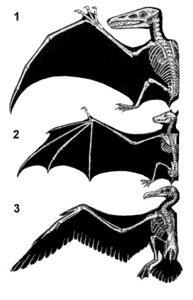Difference between revisions of "Homologous"
(Created page with 'File:lighterstill.jpg[[File:Homology.jpg|right|frame|<center>The wings of pterosaurs (1), bats (2) and birds (3) are analogous as wings, but '''homologous''' as forearms</cen...') |
m (Text replacement - "http://" to "https://") |
||
| Line 3: | Line 3: | ||
==Origin== | ==Origin== | ||
[[Greek]] homologos [[agree]]ing, from hom- + legein to say | [[Greek]] homologos [[agree]]ing, from hom- + legein to say | ||
| − | *[ | + | *[https://en.wikipedia.org/wiki/17th_century 1660] |
==Definitions== | ==Definitions== | ||
*1a : having the same [[relative]] position, [[value]], or [[structure]]: as (1) : exhibiting biological homology (2) : having the same or allelic genes with genetic loci usually arranged in the same order <homologous chromosomes> | *1a : having the same [[relative]] position, [[value]], or [[structure]]: as (1) : exhibiting biological homology (2) : having the same or allelic genes with genetic loci usually arranged in the same order <homologous chromosomes> | ||
| Line 9: | Line 9: | ||
*2: derived from or [[developed]] in [[response]] to [[organisms]] of the same species | *2: derived from or [[developed]] in [[response]] to [[organisms]] of the same species | ||
==Description== | ==Description== | ||
| − | A '''homologous''' trait is any characteristic of [[organisms]] that is derived from a common [[ancestor]]. This is [[contrasted]] to [[analogous]] traits: similarities between [[organisms]] that were not in the last common [[ancestor]] of the taxa being considered but rather [ | + | A '''homologous''' trait is any characteristic of [[organisms]] that is derived from a common [[ancestor]]. This is [[contrasted]] to [[analogous]] traits: similarities between [[organisms]] that were not in the last common [[ancestor]] of the taxa being considered but rather [https://en.wikipedia.org/wiki/Convergent_evolution evolved separately]. As defined by Owen, a homology is a "[[structural]] [[correspondence]]", whereas an [[analogy]] is a "non-correspondent similarity". |
| − | Whether or not a trait is homologous depends on both the taxonomic and anatomical level at which the trait is [[examined]]. For example, the bird and [ | + | Whether or not a trait is homologous depends on both the taxonomic and anatomical level at which the trait is [[examined]]. For example, the bird and [https://en.wikipedia.org/wiki/Bat_wing bat wing] are homologous as forearms in [https://en.wikipedia.org/wiki/Tetrapod tetrapods]. However, they are not homologous as wings, because the organ served as a forearm (not a wing) in the last [https://en.wikipedia.org/wiki/Common_descent common ancestor] of tetrapods. By definition, any homologous trait defines a [https://en.wikipedia.org/wiki/Clade clade]—a [https://en.wikipedia.org/wiki/Monophyly monophyletic] [https://en.wikipedia.org/wiki/Taxon taxon] in which all the members have the trait (or have lost it secondarily); and all non-members lack it. |
A homologous trait may be homoplasious – that is, it has evolved [[independently]], but from the same [[ancestral]] [[structure]] – plesiomorphic – that is, present in a common ancestor but secondarily lost in some of its descendants – or (syn)apomorphic – present in an ancestor and all of its descendants.[1] | A homologous trait may be homoplasious – that is, it has evolved [[independently]], but from the same [[ancestral]] [[structure]] – plesiomorphic – that is, present in a common ancestor but secondarily lost in some of its descendants – or (syn)apomorphic – present in an ancestor and all of its descendants.[1] | ||
| − | A homologous trait is often called a '''homolog''' (also spelled homologue). In [[genetics]], the term "homolog" is used both to refer to a homologous [[protein]], and to the gene ([[DNA]] sequence) encoding it.[ | + | A homologous trait is often called a '''homolog''' (also spelled homologue). In [[genetics]], the term "homolog" is used both to refer to a homologous [[protein]], and to the gene ([[DNA]] sequence) encoding it.[https://en.wikipedia.org/wiki/Homology_(biology)] |
[[Category: Biology]] | [[Category: Biology]] | ||
Latest revision as of 00:58, 13 December 2020
Origin
Greek homologos agreeing, from hom- + legein to say
Definitions
- 1a : having the same relative position, value, or structure: as (1) : exhibiting biological homology (2) : having the same or allelic genes with genetic loci usually arranged in the same order <homologous chromosomes>
- b : belonging to or consisting of a chemical series whose successive members have a regular difference in composition especially of one methylene group
Description
A homologous trait is any characteristic of organisms that is derived from a common ancestor. This is contrasted to analogous traits: similarities between organisms that were not in the last common ancestor of the taxa being considered but rather evolved separately. As defined by Owen, a homology is a "structural correspondence", whereas an analogy is a "non-correspondent similarity".
Whether or not a trait is homologous depends on both the taxonomic and anatomical level at which the trait is examined. For example, the bird and bat wing are homologous as forearms in tetrapods. However, they are not homologous as wings, because the organ served as a forearm (not a wing) in the last common ancestor of tetrapods. By definition, any homologous trait defines a clade—a monophyletic taxon in which all the members have the trait (or have lost it secondarily); and all non-members lack it.
A homologous trait may be homoplasious – that is, it has evolved independently, but from the same ancestral structure – plesiomorphic – that is, present in a common ancestor but secondarily lost in some of its descendants – or (syn)apomorphic – present in an ancestor and all of its descendants.[1]
A homologous trait is often called a homolog (also spelled homologue). In genetics, the term "homolog" is used both to refer to a homologous protein, and to the gene (DNA sequence) encoding it.[1]
